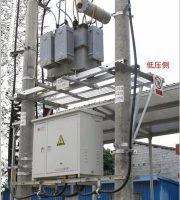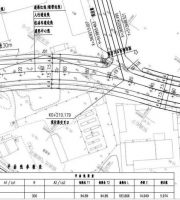The author suggested that the cracking should be controlled through concrete raw materials and on-site construction management, and the cracking situation should be greatly improved.
During concrete pouring, professional and experienced personnel shall be sent to check the support rod to see whether it is loose.
The position of hanging formwork shall be reinforced in place without penetrating the floor; Strengthen the plate reinforcement at the local position of the material transfer port, flue and other openings.
When vibrating, it shall be inserted quickly and pulled out slowly.
◇ the spacing of support rods shall not be greater than 2m.
In order to prevent the rapid evaporation of concrete moisture, film covering measures can be taken to alleviate it.
Take the author’s project as an example: four steel back ribs on the inner wall of the standard floor and five steel back ribs on the outer wall; The distance from the vertical support of the wall shall not be greater than 750mm, and the mid span distance shall not be greater than 1200mm; The first diagonal brace at the end of internal and external corner wall shall not be greater than 600mm; The end of the external corner is provided with an external corner lock or a screw for opposite pulling.
◇ after the pouring of the floor slab surface, the plate vibrator shall be used for vibration, and the moving distance shall ensure that the plate of the vibrator covers the edge of the vibrated part.
For the junction of beam slab and wall slab, secondary vibration shall be carried out before the initial setting of concrete.
It shall be vibrated evenly, and the moving distance should be 20-30cm.
Due to their different physical and mechanical properties, various volume changes are also different under the change of temperature and humidity.
◇ the aluminum formwork support system should be reinforced in place according to the scheme.
The temperature is high during the interval.
In specific construction, the spacing of support rods exceeds 2m due to different room sizes.
◇ at present, the aluminum mold quick disassembly system has been relatively mature, but how to avoid floor cracking is a “stumbling block” on the road of rapid promotion of the system.
If it is necessary to be intermittent, the interval time shall be shortened as far as possible, and the secondary layer of concrete shall be poured before the initial setting of the previous layer of concrete.
◇ during the pouring process, the supervision and construction shall strictly implement the on-site system: timely correct the pouring and vibration in place and the trampling of reinforcement in the construction process, strictly control the thickness of floor slab and the thickness of reinforcement protective layer, and it is strictly prohibited to pour and tamp the pipe moistening mortar in the concrete structure.
When vibrating the upper layer, it shall be inserted into the lower layer for 10cm to make the two layers of concrete firmly combined.
The popularization and application of aluminum mold can improve the construction environment, improve the process quality, and promote the improvement of product standardization in reverse.
Once it is loose, it shall be tightened immediately.
The maximum interval shall be determined according to the type of cement used, temperature and concrete setting conditions.
The insertion points shall be evenly arranged, moved point by point and carried out in sequence without omission.
If the roof concrete strength reaches 50%, the roof formwork will be removed, which is easy to produce cracks after formwork removal.
◇ secondary vibration shall be carried out before receiving.
Vibrating rod shall be used at the junction of beam slab and beam wall, and the plate surface shall be covered with film after plate vibration.
Therefore, it is difficult for aluminum plywood to set pre arch as effectively as wood formwork, resulting in some irregular cracks after formwork removal.
◇ during the hydration process, the concrete mixture will produce plastic deformation due to its characteristics of wet expansion, dry shrinkage, thermal expansion and cold shrinkage.
During construction, the support rod shall be tightened.
03 concrete curing ◇ after the concrete floor slab is poured, the surface scraping shall be limited to the minimum.
◇ the concrete pouring shall be carried out continuously.
Arrange testers to make standard curing test blocks and curing test blocks under the same conditions, and give timely detection feedback.
The strict control of the support system is an important starting point to ensure the pouring quality and prevent cracking.
The wall column concrete shall be poured and vibrated in layers.
The material transfer opening of aluminum formwork must be set in the room or at a position with a depth of about 1 / 4.
The standard layer shall be 1 / 3 of the layer height.
In addition, the time of on-site formwork removal shall be guided according to the test data of the test block under the same conditions.
◇ the rigidity of aluminum alloy formwork is large, and the rigid connection between formwork and formwork is mainly adopted by pins.
◇ the immersion vibrator shall be used in the pouring process.
When the shrinkage tensile stress inside the concrete exceeds the ultimate tensile strength of the concrete, cracks will occur.
The support system shall be calibrated twice before pouring.
In this regard, the project needs to organize the general contractor and the supervision unit to conduct random inspection on the raw materials of the concrete mixing plant from time to time (it is suggested that at least once a month), mainly including the selection of cement, aggregate gradation, mud content and type, admixture and mineral admixture.
The author observed the situation of the project and found that the floor cracking was mainly concentrated at the junction of beams and slabs, and the slab showed vertical and horizontal spider web cracking.
At the same time, holes shall be set around the material transfer opening according to the normative requirements to strengthen the reinforcement.
In this position, the bending moment is small, which can avoid cracks due to stress concentration.
After the floor slab is poured, the slab surface shall be covered and insulated with materials in time and carefully maintained to prevent exposure to strong wind and hot sun..
All flanging beams must be vibrated twice before the initial setting of concrete.
◇ every time the concrete enters the site, the slump test must be carried out and the sign must be raised for acceptance.
02 construction management ◇ special water-based release agent shall be used for aluminum formwork to ensure the forming effect ◇ the detailed structure binding of reinforcement shall be carried out in strict accordance with the specifications, and the intersection of reinforcement mesh of each vertical plane in the reinforcement framework of wall, column and beam shall be bound in full; All the intersections of the reinforcement mesh on the upper part of the slab shall be bound, and the reinforcement mesh at the bottom can be bound alternately except for the edge part; The thickness of reinforcement cover shall meet the design and specification requirements.
When these deformation are restrained, stress will be generated in the concrete.
When the vibrator is used, the distance between the vibrator and the formwork shall not be more than 30cm, and it shall not be close to the formwork.
Generally, more than 2H shall be treated as construction joint.
In combination with the test data and results of the test block pressure test, timely feed back the concrete mixing plant and require the mix proportion analysis.
◇ reasonably set the material transfer port.
01 raw materials ◇ concrete is composed of cement, stone, sand, water, admixtures and other materials.
Discussion on prevention and control of floor cracks in aluminum formwork construction ◇ the traditional construction industry is transforming towards the direction of “environmental protection, high efficiency, high quality and safety”.
Strengthen the early curing of concrete.


